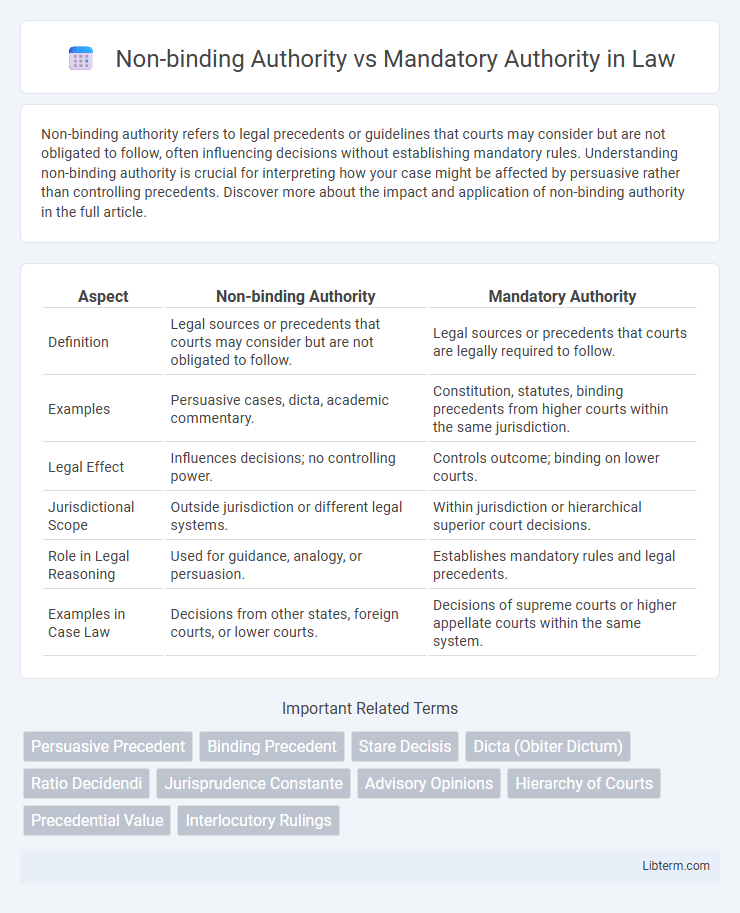Non-binding authority refers to legal precedents or guidelines that courts may consider but are not obligated to follow, often influencing decisions without establishing mandatory rules. Understanding non-binding authority is crucial for interpreting how your case might be affected by persuasive rather than controlling precedents. Discover more about the impact and application of non-binding authority in the full article.
Table of Comparison
| Aspect | Non-binding Authority | Mandatory Authority |
|---|---|---|
| Definition | Legal sources or precedents that courts may consider but are not obligated to follow. | Legal sources or precedents that courts are legally required to follow. |
| Examples | Persuasive cases, dicta, academic commentary. | Constitution, statutes, binding precedents from higher courts within the same jurisdiction. |
| Legal Effect | Influences decisions; no controlling power. | Controls outcome; binding on lower courts. |
| Jurisdictional Scope | Outside jurisdiction or different legal systems. | Within jurisdiction or hierarchical superior court decisions. |
| Role in Legal Reasoning | Used for guidance, analogy, or persuasion. | Establishes mandatory rules and legal precedents. |
| Examples in Case Law | Decisions from other states, foreign courts, or lower courts. | Decisions of supreme courts or higher appellate courts within the same system. |
Introduction to Legal Authority: Non-Binding vs. Mandatory
Non-binding authority refers to legal sources, such as persuasive precedents or secondary materials, that courts may consider but are not obliged to follow, whereas mandatory authority consists of binding precedents or statutory laws that courts must adhere to within their jurisdiction. Understanding the distinction between non-binding and mandatory authority is crucial for legal practitioners when analyzing case law or statutory interpretation to determine the weight and applicability of various legal sources. Courts rely on mandatory authority to ensure consistency and predictability in legal rulings, while non-binding authority can influence decisions through persuasive reasoning or emerging trends.
Defining Non-Binding Authority
Non-binding authority refers to legal precedents or interpretations that courts may consider persuasive but are not obligated to follow, often originating from lower courts or jurisdictions outside the binding court's hierarchy. This type of authority guides judicial reasoning without imposing mandatory compliance, serving as influential yet flexible references in case law. Understanding the distinction between non-binding and mandatory authority is crucial for legal practitioners when arguing precedent applicability in various jurisdictions.
Understanding Mandatory Authority
Mandatory authority refers to legal rules or precedents that courts are obligated to follow within their jurisdiction, ensuring consistent application of the law. Unlike non-binding authority, which serves as persuasive guidance, mandatory authority compels judges to adhere strictly to established statutes and higher court decisions. Understanding mandatory authority is crucial for accurate legal analysis and predicting court outcomes, as it defines the limits of judicial discretion.
Key Differences Between Non-Binding and Mandatory Authority
Non-binding authority provides guidance or recommendations without the requirement for compliance, whereas mandatory authority imposes legally binding obligations that must be followed. Non-binding authority often influences decisions through persuasion or best practices, while mandatory authority is enforceable by law or regulation with potential penalties for non-compliance. Understanding the distinction is crucial for determining whether adherence is optional or compulsory in legal and regulatory contexts.
Sources of Non-Binding Authority
Sources of non-binding authority primarily include judicial decisions from lower courts, advisory opinions, and persuasive precedents from other jurisdictions. These sources lack mandatory force but influence decision-making by providing guidance, legal reasoning, and policy considerations. Courts often rely on non-binding authority to fill gaps in the law or interpret statutes when binding authority is absent or unclear.
Sources of Mandatory Authority
Sources of mandatory authority include constitutions, statutes, and judicial precedents that courts are legally required to follow within their jurisdiction. These authoritative sources establish binding rules and legal standards, ensuring uniformity and predictability in judicial decisions. Unlike non-binding authority, mandatory authority directly influences case outcomes and cannot be disregarded by courts.
The Role of Precedent in Legal Reasoning
Non-binding authority includes legal precedents such as persuasive decisions from lower courts or courts in other jurisdictions, which guide but do not compel judges in their rulings. Mandatory authority consists of binding precedents established by higher courts within the same jurisdiction, requiring lower courts to follow these decisions when similar legal issues arise. The role of precedent in legal reasoning ensures consistency and predictability, as mandatory authority obliges adherence to established law while non-binding authority offers flexibility and the potential for legal evolution.
Practical Implications for Legal Research
Non-binding authority, such as persuasive precedent and secondary sources, influences legal reasoning without compelling courts to follow it, allowing flexibility in argument development and strategy. Mandatory authority, including binding statutes and precedent from higher courts within the same jurisdiction, requires strict adherence, ensuring predictability and consistency in legal decisions. Understanding these distinctions is crucial for efficient legal research, as it directs the selection of sources that will either support or compel particular legal outcomes.
Situations Where Non-Binding Authority is Used
Non-binding authority is commonly used in legal research when courts reference persuasive precedents from other jurisdictions to guide their decisions without being obligated to follow them. This type of authority helps judges consider alternative interpretations, innovative legal developments, or emerging trends without the strict constraints of mandatory jurisdictional rules. Instances include citing lower court opinions, legal articles, or decisions from courts in different states or countries to support arguments or influence judicial reasoning.
Conclusion: Importance in Legal Practice
Non-binding authority offers persuasive value that supports legal arguments without controlling outcomes, while mandatory authority requires strict adherence due to its binding nature. Understanding the distinction is crucial for legal practitioners to effectively evaluate precedent strength and craft sound legal strategies. Mastery of these concepts ensures accurate application of case law, minimizing risks of judicial error and enhancing persuasive court submissions.
Non-binding Authority Infographic

 libterm.com
libterm.com